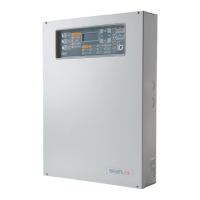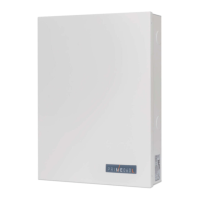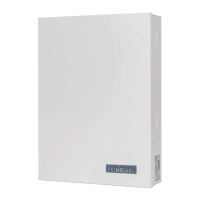Installation Manual
Connections 43
Danger: The protective earthing system must be compliant with the local safety regulations, fire
codes, laws and bylaws in force.
Note: As a further safety measure, the electrical system of the building must be protected
against overload and short-circuit.
Primary power source: 230 V ac (-15% + 10%) 50/60 Hz.
Maximum current draw : 0.9 Aac
After connecting the conductors to the power module terminals, using a cable tie, bunch the wires
together and attach them firmly to one of the cable hooks [figure 40-4] on the backbox.
The mains supply conductors must not cross other conductors. Refer to the wiring diagram [figure
40].
Note: The connection wires (to the electrical mains, and also any other wires inside the SmartLoop
cabinet) must be secured to the cable hooks on the back box by means of plastic cable ties or
similar fittings. Use cable with double isolation for the connection to the electrical mains. Ensure
that the switching power supply is properly earthed and, if you are installing a SmartLoop/PSTN,
ensure that the metal supports are tightly screwed in place, in accordance with the instructions in
this manual.
1. Connect the electrical mains power to the power supply module terminals [figure 40-5].
2. Connect Earth to terminal [FG]; Neutral to terminal [ACN] and Line to terminal [ACL].
3. Fit the two 12 V / 17 Ah internal batteries.
Use YUASA 12 V / 17 Ah batteries - model NP 17 -12 FR or similar with the case rated UL94-V2 flame
class (or higher).
Note: A protective earth connection ensures that all exposed conductive surfaces are at the same
electrical potential as the surface of the Earth, in order to avoid the risk of electrical shock if a
person touches a device in which an insulation fault has occurred. In the event of an insulation
fault, a protective earth connection will generate a high fault current which in turn will trigger an
overcurrent protection device (fuse) and disconnect the power supply.
